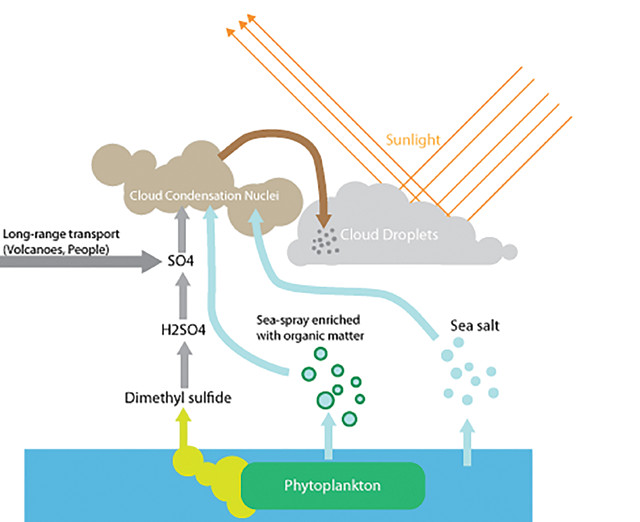
by Mary Caperton Morton Friday, October 23, 2015

Organic material lofted into the atmosphere with sea spray is a major source of cloud condensation nuclei over the Southern Ocean, particularly in the summer months when phytoplankton bloom prolifically. Credit: Daniel McCoy.
The Southern Ocean surrounding Antarctica is home to some of the most pristine air anywhere on Earth. And yet it’s also one of the cloudiest places on the planet, a seeming contradiction because water droplets require particulate matter in the air to condense into clouds. Now, a study looking at cloud droplet concentrations over the Southern Ocean is giving scientists a clearer understanding of the role played by marine microorganisms in cloud formation and climate.
Closer to land, the particulates needed to form clouds — called aerosols — are produced from a combination of pollution, dust and sea spray. But far from land in the Southern Ocean, aerosols are thought to be produced mainly by sea spray and emissions from marine microorganisms, primarily phytoplankton. In the new study, published in Science Advances, researchers quantified the impact of phytoplankton-produced aerosols and found that the microorganisms are responsible for up to half of the droplets that produce clouds over the Southern Ocean during the summer months.
The effects of aerosols produced by marine organisms have likely been underestimated and are often overlooked in climate models, says Susannah Burrows, a climate scientist at the Department of Energy’s Pacific Northwest National Laboratory in Richland, Wash., and an author of the new study. That phytoplankton should play a big part “makes sense because most of the area down there is ocean, with strong winds that kick up a lot of spray and a lot of marine organisms that produce these particles,” she says. Meanwhile, “continental aerosol sources are so far away that they only have a limited impact.”
Burrows and her colleagues combined satellite measurements of cloud droplet concentrations with a modeling program that simulated the contributions of aerosols produced by marine organisms and sea spray. “We had to use models because satellites can’t tell the difference between the types of aerosols,” Burrows notes.
The models showed that sea salt was the single biggest contributor of aerosols to the skies over the Southern Ocean, and also the most uniform source, contributing a consistent amount of aerosols year round. But the models also revealed that the contribution of aerosols from marine organisms soared during the Antarctic summer months, when massive green blooms of phytoplankton can be seen from space.
Overall, the aerosols produced by the phytoplankton almost doubled the cloud droplet concentration during the summer. This decreased the amount of sunlight that penetrated the cloud cover by a similar amount — six to eight watts per square meter — to that produced by aerosol-cloud interactions in highly polluted regions of the Northern Hemisphere.
The new study improves on past efforts to quantify the contributions of marine aerosols to cloud droplet formation, but it could be further improved by gathering data in the field, instead of relying on models, says Patricia Quinn, an atmospheric chemist at NOAA in Seattle who was not involved in the new research. “We really need to go to the Southern Ocean and make measurements to verify the model results,” she says.
The last time such measurements were taken was in the mid-1990s. “We didn’t have the instruments then that we have today,” Quinn says. “Now we could do a much better job of assessing the composition of the aerosols and making the cloud droplet measurements.” But as Burrows notes, the logistical challenges and costs to take measurements in the Southern Ocean are great. One project — called SOCRATES: The Southern Ocean Clouds, Radiation, Aerosol Transport Experimental Study — proposed by a team from the University of Washington, Woods Hole Oceanographic Institution, and others is currently seeking funding for a field mission in 2018.
A better understanding of the amount of sunlight reflected by clouds over the Southern Ocean will help inform climate models, Burrows says. “Most global climate models don’t currently include the effects of aerosols from phytoplankton, and it’s clear they’re a major contributor to cloud formation,” she says. The information from this work “gives us better constraints on what we put into the models.”
© 2008-2021. All rights reserved. Any copying, redistribution or retransmission of any of the contents of this service without the expressed written permission of the American Geosciences Institute is expressly prohibited. Click here for all copyright requests.